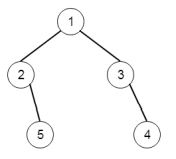
 Data Structure
Data Structure Networking
Networking RDBMS
RDBMS Operating System
Operating System Java
Java MS Excel
MS Excel iOS
iOS HTML
HTML CSS
CSS Android
Android Python
Python C Programming
C Programming C++
C++ C#
C# MongoDB
MongoDB MySQL
MySQL Javascript
Javascript PHP
PHP
- Selected Reading
- UPSC IAS Exams Notes
- Developer's Best Practices
- Questions and Answers
- Effective Resume Writing
- HR Interview Questions
- Computer Glossary
- Who is Who
Program to find the left side view of a binary tree in C++
Suppose we have a binary tree, if we see the tree from left side, then we can see some elements of it. we have to display those elements. So if the tree is like −

The output will be [1,2,5]
To solve this, we will follow these steps −
Define an array ret
Define a function dfs(), this will take node, c initialize it with 1,
-
if node is null, then −
return
-
if c > lvl, then −
lvl := c
insert value of node into ret
dfs(left of node, c + 1)
dfs(right of node, c + 1)
From the main method, do the following −
lvl := -1
dfs(root, 0)
-
return ret
Let us see the following implementation to get better understanding −
Example
#include <bits/stdc++.h>
using namespace std;
void print_vector(vector<int> v){
cout << "[";
for(int i = 0; i<v.size(); i++){
cout << v[i] << ", ";
}
cout << "]"<<endl;
}
class TreeNode{
public:
int val;
TreeNode *left, *right;
TreeNode(int data){
val = data;
left = right = NULL;
}
};
class Solution {
public:
vector <int> ret;
int lvl;
void dfs(TreeNode* node, int c = 1){
if(!node)
return;
if(c > lvl){
lvl = c;
ret.push_back(node->val);
}
dfs(node->left, c + 1);
dfs(node->right, c + 1);
}
vector<int> solve(TreeNode* root) {
lvl = -1;
dfs(root, 0);
return ret;
}
};
main(){
TreeNode *root = new TreeNode(1);
root->left = new TreeNode(2);
root->right = new TreeNode(3);
root->left->right = new TreeNode(5);
root->right->right = new TreeNode(4);
Solution ob;
print_vector(ob.solve(root));
}
Input
TreeNode *root = new TreeNode(1); root->left = new TreeNode(2); root->right = new TreeNode(3); root->left->right = new TreeNode(5); root->right->right = new TreeNode(4);
Output
[1,2,5]

Advertisements
